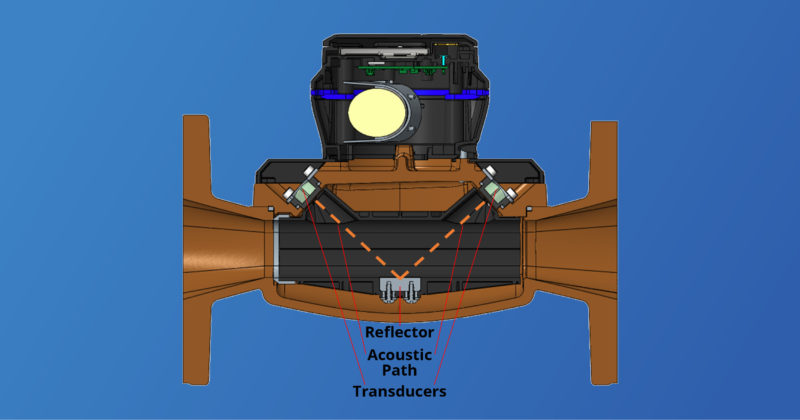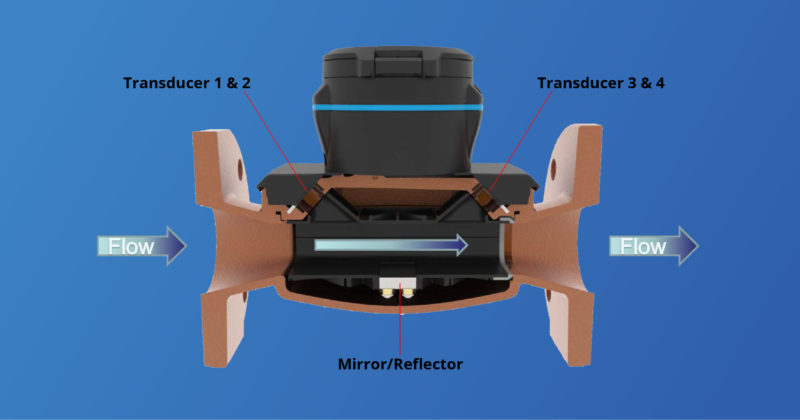How Do Ultrasonic Water Meters Work?
By Tom Garrity, Director of Sales, Ti-SALES

Ultrasonic water meters are some of the most in-demand meters on the market, and for good reason: they’re highly accurate, low-maintenance, and easy to install. But how do they measure water flow without any moving parts?
Ultrasonic: a Static Water Meter Technology
Ultrasonic water meters are a type of static, or solid-state, water meters (other types of solid-state meters include electromagnetic field meters or “mag meters”). In other words, they have no moving parts, much like a modern computer hard drive. Unlike mechanical water meters, they require a power source and what they measure is the velocity of the water, from which they calculate the flow rate.
The benefits of solid-state meters are numerous.
- No moving parts means no clogs – and that means lower maintenance!
- Solid-state meters have greater accuracy over time, as moving parts inevitably degrade over their many years in service.
- In the case of ultrasonic metering, the technology can be scaled in size, making it possible to have one family of meters for almost every application.
- Solid-state meters are lighter than their mechanical equivalents, making them easier to transport and install.
- Because the measuring chamber is open, water flowing through a solid-state meter loses less pressure than when flowing through a mechanical meter – in other words, a more efficient water system.
The downsides to solid-state meters are relatively few.
- This meter type requires power, meaning either electric current or a battery. Either method introduces a possible failure point (a loss of power or a dying battery).
- Some solid-state meters are susceptible to “noise” (stray currents or signals from other components), which if not accounted for can cause an inaccurate reading.
- Because solid-state meters measure the velocity of the water as opposed to the volume, the measuring chamber must remain at “full pipe” for accurate measurement. In other words, air trapped in the meter can create inaccuracy.
Ultrasonic meters aren’t the only type of solid-state meters, but they have key advantages. For one, ultrasonic meters are excellent at making extremely low-flow measurements. This has a two-part benefit: it increases the revenue of water utilities by measuring every drop, and it can detect leaks that cost customers money – or even threaten to damage their home or business if left unchecked!
Additionally, ultrasonic technology is very energy-efficient, meaning that the meter’s batteries can have a very long life. This makes it possible to have a high sampling rate, which again leads to a very high accuracy for the entire life of the meter. State-of-the-art ultrasonic water meters can sample as often as four times a second – in contrast, some electromagnetic water meters are limited to sampling as infrequently as once every thirty seconds.
Theory of Ultrasonic Operation: It’s All in the Timing

Ultrasonic water meters measure the water’s velocity through transit time measurement: the meter sends an ultrasonic sound wave through the fluid both with the flow and against the flow. A transducer upstream generates a wave which is bounced off a mirror and sent to a transducer downstream; then, the same process happens in reverse. The difference in transit time for the two directions can then be used to determine the flow rate.
To help understand how this works, imagine a boat traveling down river that then turns around to head upriver. Traveling upriver is noticeably slower than when the boat was traveling downriver, meaning the boat will take longer to travel the same distance. This same principle is used to precisely measure the velocity of water passing through an ultrasonic water meter.
Ultrasonic meters are largely unaffected by noise due to their high signal-to-noise ratio.
Summing Up…
Ultrasonic water meters are arguably the best water meters on the market today. They’re highly accurate over time due to their high sampling rate, which is made possible by their energy-efficient technology. They are easy to install since they’re more lightweight than their mechanical meter equivalents (which also makes them easier to transport!). They require less maintenance since they have no moving parts that can clog or wear.
All in all, ultrasonic water meters are an excellent choice for any water utility.
 Tom Garrity is the Director of Sales for Ti-SALES, a leading distributor of water and wastewater supplies and the exclusive supplier for Neptune Technology Group’s line of water metering products across all of New England and New York. Neptune’s MACH® 10 Ultrasonic Water Meter is available in sizes from 5/8” all the way to 12” to support both residential and commercial and industrial use. 3- 6” sizes are available in multiple lay lengths to accommodate replacement of different styles of mechanical meters; additionally, all units 3” and up feature a Unitized Measuring Element (UME) which can be replaced without removing the meter body.
Tom Garrity is the Director of Sales for Ti-SALES, a leading distributor of water and wastewater supplies and the exclusive supplier for Neptune Technology Group’s line of water metering products across all of New England and New York. Neptune’s MACH® 10 Ultrasonic Water Meter is available in sizes from 5/8” all the way to 12” to support both residential and commercial and industrial use. 3- 6” sizes are available in multiple lay lengths to accommodate replacement of different styles of mechanical meters; additionally, all units 3” and up feature a Unitized Measuring Element (UME) which can be replaced without removing the meter body.